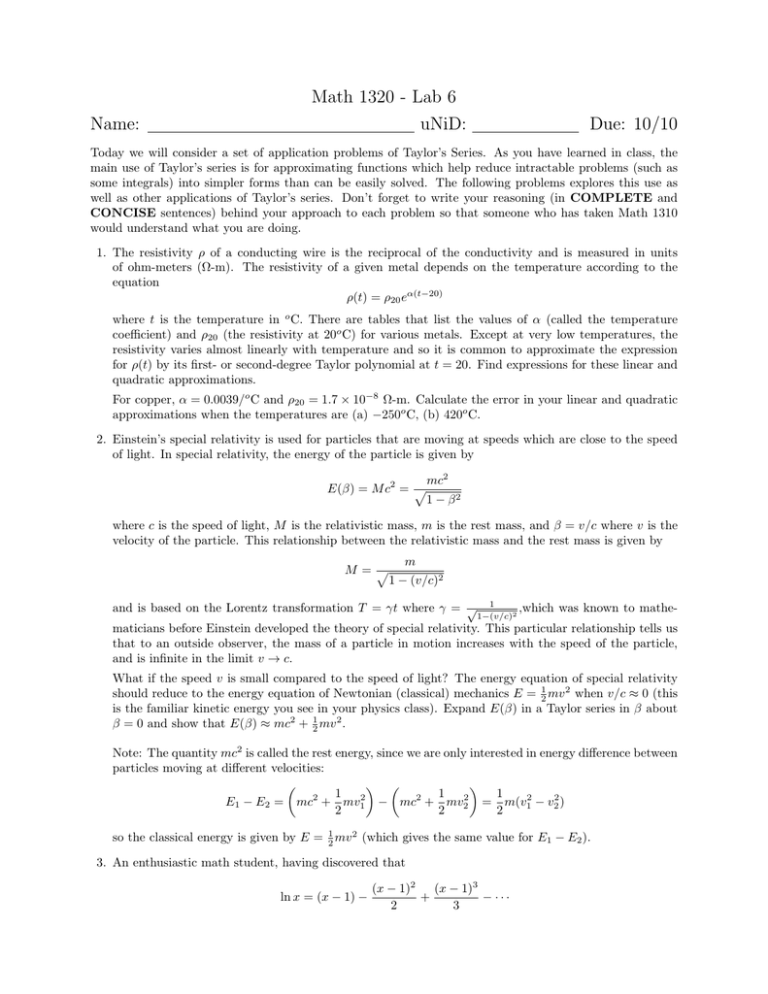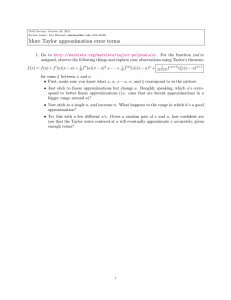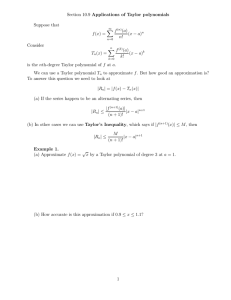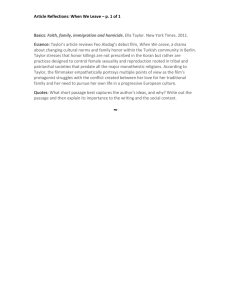Math 1320 - Lab 6 Name: uNiD: Due: 10/10
advertisement

Math 1320 - Lab 6 uNiD: Name: Due: 10/10 Today we will consider a set of application problems of Taylor’s Series. As you have learned in class, the main use of Taylor’s series is for approximating functions which help reduce intractable problems (such as some integrals) into simpler forms than can be easily solved. The following problems explores this use as well as other applications of Taylor’s series. Don’t forget to write your reasoning (in COMPLETE and CONCISE sentences) behind your approach to each problem so that someone who has taken Math 1310 would understand what you are doing. 1. The resistivity ρ of a conducting wire is the reciprocal of the conductivity and is measured in units of ohm-meters (Ω-m). The resistivity of a given metal depends on the temperature according to the equation ρ(t) = ρ20 eα(t−20) where t is the temperature in o C. There are tables that list the values of α (called the temperature coefficient) and ρ20 (the resistivity at 20o C) for various metals. Except at very low temperatures, the resistivity varies almost linearly with temperature and so it is common to approximate the expression for ρ(t) by its first- or second-degree Taylor polynomial at t = 20. Find expressions for these linear and quadratic approximations. For copper, α = 0.0039/o C and ρ20 = 1.7 × 10−8 Ω-m. Calculate the error in your linear and quadratic approximations when the temperatures are (a) −250o C, (b) 420o C. 2. Einstein’s special relativity is used for particles that are moving at speeds which are close to the speed of light. In special relativity, the energy of the particle is given by E(β) = M c2 = p mc2 1 − β2 where c is the speed of light, M is the relativistic mass, m is the rest mass, and β = v/c where v is the velocity of the particle. This relationship between the relativistic mass and the rest mass is given by M=p m 1 − (v/c)2 and is based on the Lorentz transformation T = γt where γ = √ 1 ,which 1−(v/c)2 was known to mathe- maticians before Einstein developed the theory of special relativity. This particular relationship tells us that to an outside observer, the mass of a particle in motion increases with the speed of the particle, and is infinite in the limit v → c. What if the speed v is small compared to the speed of light? The energy equation of special relativity should reduce to the energy equation of Newtonian (classical) mechanics E = 21 mv 2 when v/c ≈ 0 (this is the familiar kinetic energy you see in your physics class). Expand E(β) in a Taylor series in β about β = 0 and show that E(β) ≈ mc2 + 12 mv 2 . Note: The quantity mc2 is called the rest energy, since we are only interested in energy difference between particles moving at different velocities: 1 1 1 E1 − E2 = mc2 + mv12 − mc2 + mv22 = m(v12 − v22 ) 2 2 2 so the classical energy is given by E = 21 mv 2 (which gives the same value for E1 − E2 ). 3. An enthusiastic math student, having discovered that ln x = (x − 1) − (x − 1)2 (x − 1)3 + − ··· 2 3 decides to save money by not buying the scientific feature on his new calculator, figuring that all he has to do is to use this formula to calculate ln x. Being somewhat lazy, he decides that the formula ln x = (x − 1) − (x − 1)2 2 is ”probably accurate to three decimal places.” Comment on this speculation with complete and concise sentences and give example(s) of when this speculation fails. Your friend tells you that the formula ln x = (x − 1) − (x − 1)2 2 is ”definitely accurate to three decimal places provided x is close enough to 1.” How close? (Hint: Use Alternating Series Estimation Theorem)


